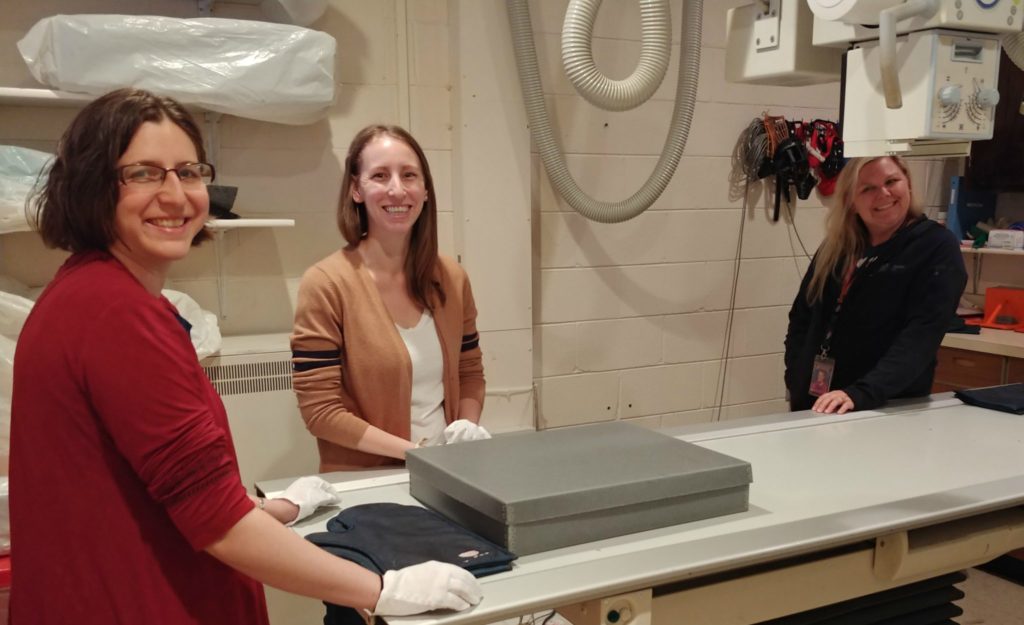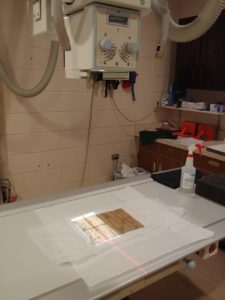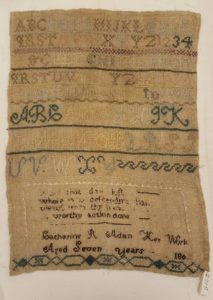
Katie Knowles, Megan Osborne, and Lonna Jensen prior to X-raying the centuries-old embroidery sampler.
Veterinary care and historic textiles don’t often intersect, but recently the staff at the Avenir Museum of Design and Merchandising and Colorado State University’s James L. Voss Veterinary Teaching Hospital collaborated in an effort to solve a needlework mystery.
The team joined forces to further examine the details of an embroidery sampler from the Avenir collection in hopes of contributing to its preservation. Age had rendered a section of the stitching unreadable, and a textile conservator recommended X-raying the fabric to help decipher the letters.
The sampler dates back to 1802 and was crafted by 7-year-old Catharine R. Adan, in Boston, Massachusetts, but eventually found its home at CSU’s Avenir Museum collection in 2015.
Curator of the Avenir Museum Katie Knowles and Collections Manager Megan Osborne enlisted the help of Dr. Sean Adams and the hospital diagnostic imaging staff to X-ray the centuries-old linen sampler.

Trial and error
Using the hospital’s radiography machine, Adams scanned the sampler in order to view dye residue within the fabric. By finding traces of iron oxide within the canvas of the sampler, Knowles and Osborne hoped that some of the missing text could be deciphered.
“Black ink often contained an iron mordant, which would bind the dye to the thread,” Knowles said. “But the iron can also cause the thread to deteriorate.”
Once X-rayed, Adams examined the results, but unfortunately, the scan did not show much more than what Knowles and Osborne had already concluded.
However, the Avenir staff thinks they may have deciphered the passage through online research by Avenir Museum Director of Operations and Engagement Doreen Beard.
“Doreen was able to find a very similar passage through some Google sleuthing,” Knowles said. “We believe it is a proverb reading: ‘Count the day lost / whose low descending sun / views in thy hands / no worthy action done.’
“We don’t know the source of the proverb, but it is likely related to the Christian proverb ‘idle hands are the devil’s playground,’ and speaks to the importance of industriousness in early America,” Knowles added.
About the sampler
“Schoolgirl samplers are very common from the late 1700s to early 1800s,” Knowles said. “This was something that girls would do at school, and they would be graded and assessed on their ability to successfully complete a sampler.”

Samplers would often contain arithmetic, writing, and stitching in a variety of fonts and stitch types.
“A sampler is a ‘sample’ of the different stitches the girls would learn to make. It was meant to display her skill as a young girl, which would then determine her skills to be a good and proper wife,” Knowles said.
The Avenir Museum was awarded $1,000 from the Sampler Guild of the Rockies to conserve the 1802 embroidery sampler. The Sampler Guild of the Rockies provides grants to institutions that seek to collect, curate, and preserve historic samplers from around the world.
Though the process did not entirely go according to plan, the Avenir Museum and CSU Veterinary Teaching Hospital teams both feel it was worth a try.
“This was the most still one of our patients has ever been,” Lonna Jensen, the radiologic technologist who performed the scan, said with a laugh.

Next steps
Knowles and Osborne are still working to preserve the 19th century fabric artifact.
“Our next step is to talk with the textile scientist in the Department of Design and Merchandising about the possibility of taking some small thread samples from the back side of the sampler to do chemical analysis,” said Knowles.
“We would select different colors of thread samples in hopes of finding out what dyes were used to color the thread,” she continued. “If we can determine the chemical makeup of the dyes, we may be able to do additional scanning using other equipment or alternate settings that might give us a better image of the complete original embroidered design. This would also help us determine the likely original color of the alphabet letters, some of which have faded significantly.”
The Avenir Museum of Design and Merchandising is part of the Department of Design and Merchandising in CSU’s College of Health and Human Sciences.